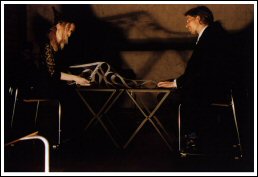Earshot
Art Clay & Franziska Martinsen
"Le Mariage" and "Am Laufenden Band"
Open Space
8 pm, Sunday, January 29th
Art Clay (born in New York, lives in Basel, Switzerland) has worked in Music, Video & performance. He regards himself as a specialist in the performance of self created works with the use of intermedia. Appearances at international festivals, on radio and television in Europe, USA, Canada, and Japan. He has written works for newly invented instruments of his own design and for traditional acoustic and electro-acoustic instruments. Recently, his work has focused on large-scale performative music-theater works and public art spectacles using mobile devices. Together with Prof. Jürg Gutknecht, he directs the 'Digital Art Weeks' Program held at the ETH in Zurich.
Franziska Martinsen holds an M.A. in Philosophy, Political Theory and Music Sciences (2002) from the Humbold-University in Berlin, Germany, and works a Research Assistant at the Philosophical Institute at the University of Basel, Switzerland, (since 2003). During and after her studies, she worked as a dramatic adviser and text writer for various music theatre productions based in Berlin and Basel. In 2000, she organised an international touring exhibition about female philosophers. Since 2003 she lectured both at the Philosophical Institute and at the Centre for Gender Studies, University of Basel, on various topics. Her research interests lie in political theory and ethics with emphasis on global justice.

Le Mariage (1996)
A composition for two Swiss music boxes for two performers inspired by “La Mariee mise a nu par ses celibataires meme” from Marcel Duchamp. The piece was composed in a similar manner to that of Duchamp’s. Instead of building a mechanical apparatus similar to that employed by Duchamp, I wrote a computer program to do a somewhat related task. The program basically selects tones from a given collection and range and writes them out into a readable score. After several runs and versions of the program, I decided to stick with a variation in which some of the balls (tones) remained in the wagons (phrases) as they were pushed through (determined) for a second, third or even fourth time. In comparison to the machine used by Duchamp, this process gives the music for which it is used to generate less of a Dadist basis and in terms of music a sense of progression. The procedure was carried out twice, in order to provide music for each of the two music boxes. The score was then transcribed onto two six meter long punch cards (very much like those used on early computers) so that it could be played with the music boxes by a two performers. On the cards, the space between the tone(s) is even and is therefore determined only by the tempo of turning the music box cranks. The flux in synchronization and non-synchronization between the two voices creates shifting rhythmic patterns, which modulate slowly over time. The music box was decided upon as an instrument, because the tones can be restricted to the diatonic range. These ranges overlap, yielding strange reversed patterned echoes of harmony throughout the piece. The performers not only mirror the musical aspects of the work, but bring the piece it into the realm of performance- or music theater.

Am Laufenden Band (1998)
This is a work for flute solo that explores dynamic projection of a single sound source through locative techniques. It also uses a concept of the found object to derive compositional material in that the themes of the work have been derived by scanning the outlines of a collection of Swiss cookie cutters into a database. Each cookie cutter outline in the database was then used as a base set of melodic forms from which a collection of variations was generated. The variations were generated by using a self-written computer program to change the resolution in terms of curve and continuance in step. Each of the cookie cutters used in the process possess a simple and recognizable form. By selecting the proper variation generated by the computer program, it was possible to come closer to creating a melody that fit the cookie cutter form sonically by selection and adaptation. Therefore, a melodic profile is clearly stated by each of the forms and through the use of compositional methods they are transformed into melodies, resembling their physical counterparts in sound. A star, a four leaf clover, an angel, the Swiss cross, a heart amongst others are a few of the forms. After decisions involving position, size and amount of line were decided, the forms were transferred to music manuscript paper. Although not rendered on the whole, the forms are easily recognized on the manuscript paper when viewed from the correct angle.
|
|

